Depression Facts
Depression is a serious medical illness and an important public health issue. Globally an estimated 300 million people of all ages suffer from depression.1 Depression is one of the most common mental disorders in the United States.
In 2021, around 21.0 million adults age 18 or older in the U.S experienced at least one major depressive episode within the year. This number represented 8.3% of U.S. adults. Also, in 2021, approximately 3.7 million adolescents (ages 12-17) in the U.S. had at least one major depressive episode with severe impairment within the past year. This represents 14.7.% of the U.S population ages 12-17. Approximately 40.6% of U.S. adolescents who suffered from a major depressive episode received treatment in 2020.2
Depression is characterized by persistent sadness and sometimes irritability (particularly in children). Depression can cause suffering for depressed individuals and can also have negative effects on their families. It can occur at any time over a person’s life. Click here for a link to Depression and Treatment for Anxiety and Depression. 3
Many people who experience depression also have other mental health conditions.4 For example, nearly one-half of those diagnosed with depression are also diagnosed with an anxiety disorder. However, it should be noted they are different disorders with no evidence one disorder causes the other. 5
Depression is more than just feeling down or having a bad day. When a sad mood lasts for a long time and interferes with normal functioning, you may be depressed.6
 Types of Depression
Types of Depression
To be diagnosed with depression, the symptoms must last for at least two weeks. Some forms of depression are slightly different, and they may develop under unique circumstances.
Click on the following links to learn more about different types of depression: Types of depression as provided by the National Institute of Mental Health.7 Types of depression as provided by the Anxiety and Depression Association of America (ADAA).8
Signs and Symptoms of Depression
Just like with any mental health condition, people with depression or who are going through a depressive episode (also known as major or clinical depression) experience symptoms differently. Not everyone who is depressed experiences every symptom. Some experience only a few symptoms, while others experience many. Listed below are common symptoms:
- Changes in sleep
- Changes in appetite
- Lack of energy
- Lack of interest
- Low self-esteem
- Hopelessness
- Changes in movement
- Physical aches and pains 9
In addition to the symptoms set forth above, the National Institute of Mental Health also lists the following symptoms for depression:
- Persistent sad, anxious, or “empty” mood
- Feelings of hopelessness, or pessimism
- Irritability
- Feelings of guilt, worthlessness, or helplessness
- Loss of interest or pleasure in hobbies and activities
- Decreased energy or fatigue
- Moving or talking more slowly
- Feeling restless or having trouble sitting still
- Difficulty concentrating, remembering, or making decisions
- Difficulty sleeping, early-morning awakening, or oversleeping
- Appetite and/or weight changes
- Thoughts of death or suicide, or suicide attempts
- Aches or pains, headaches, cramps, or digestive problems without a clear physical cause and/or that do not ease even with treatment10

Lean on Others When You Need Support
Causes of Depression
Depression does not have a single cause. It can be triggered, or it may occur spontaneously without being associated with a life crisis, physical illness, or another risk. Scientists believe many factors contribute to depression. Click on the following link to the National Alliance on Mental Illness (NAMI) website for more detail on each of the possible causes listed below.
- Trauma
- Genetics
- Life Circumstances
- Brain Structure
- Other Medical Conditions
- Drug and Alcohol Abuse11
Suicide Facts
Global Statistics
According to the World Health Organization (WHO) and based on the latest evidence through October, 2020, more than 700,000 people died by suicide in 2019, which is one in every 100 deaths worldwide. Sadly, this number is typically seen each year. There are twenty times as many attempts.
Worldwide, suicide is the 4th leading cause of death among people aged 15-29. Specific rates vary between countries, regions and sexes.12

2020 U.S. Statistics
In the United States, suicide rates steadily increased 35% from 1999 to 2018 for both males and females, for all ages between 10-74, and for nearly all race and Hispanic origin groups.
In 2019, for the first time in almost 20 years, there was a decline in suicide rates. The rate declined overall was by 2%.
Between 2019 and 2020, the suicide rates overall declined once again, now by 3%. (In 2019, 47,511 deaths and in 2020, 45,855 deaths.
2020 is the latest year of reporting. Suicide rates have a lag in reporting because it can take longer to get an accurate cause of death stating that it was from suicide.
For males in 2020, (36,508) suicides were 2% lower than in 2019 (37,256). For females in 2020, (9,347) suicides were 9% lower than (10,255) in 2019. In total, 45,855 people died in the U.S. by suicide in 2020.
There was a statistically insignificant increase for both sexes in the age group 10-14 and 15-24 years, while there was a 5% increase for the age group 25-34. All people in age groups 35-44, 45-54, 55-64 and 65-74 had significant declines. The largest decline was in the age group 45-54 (from 19.6% to 17.9%) and 55-64 (from 19.4% to 16.8%).
Although there was an overall decline in suicide rates during 2019 and 2020, it is significant to note that Hispanic men had an increase by 5% and there was lesser increases (but increases, nevertheless) for Non-Hispanic black men and Non-Hispanic American Indian men.13
Warning Signs of Suicide
- Talking about wanting to die or wanting to kill themselves
- Talking about feeling empty, hopeless, or having no reason to live
- Making a plan or looking for a way to kill themselves, such as searching online, stockpiling pills, or buying a gun
- Feeling unbearable pain (emotional and physical)
- Talking about being a burden to others
- Using alcohol or drugs more often
- Acting anxious or agitated
- Withdrawing from family and friends
- Changing eating and/or sleeping habits
- Showing rage or talking about seeking revenge
- Displaying extreme mood swings, suddenly changing from very sad to very calm or happy14 15
- Talking about great guilt or shame
- Talking about feeling trapped or feeling that there are no solutions
- Taking significant risks that could lead to death, such as driving extremely fast
- Talking or thinking about death often
- Giving away important possessions
- Saying goodbye to friends and family
- Putting affairs in order, making a will16
Risk Factors of Suicide
Risk factors are often confused with warning signs of suicide, and frequently suicide prevention materials mix the two into lists of “what to watch for.” However, factors identified as increasing risk are not factors that cause or predict a suicide attempt. Risk factors are characteristics that make it more likely that an individual will consider, attempt, or die by suicide.
- Mental disorders, particularly mood disorders, schizophrenia, anxiety disorders, and certain personality disorders
- Alcohol and other substance use disorders
- Hopelessness
- Impulsive and/or aggressive tendencies
- History of trauma or abuse
- Major physical illness
- Previous suicide attempt(s)
- Family history of suicide
- Job or financial loss
- Loss of relationship(s)
- Easy access to lethal means
- Local clusters of suicides
- Lack of social support and sense of isolation
- The stigma associated with asking for help
- Lack of health care, especially mental health and substance abuse treatment
- Cultural and religious beliefs, such as the belief that suicide is a noble resolution of a personal dilemma
- Exposure to others who have died by suicide (in real life or via the media and internet)17
- Chronic pain
- Certain medical conditions
- Family history of mental disorder or substance abuse
- Family violence including physical or sexual abuse
- Having guns or firearms in the home
- Having been released recently from prison or jail18
Many people have some of these risk factors but do not attempt suicide. Suicide is not a normal response to stress. Suicidal thoughts or actions are a sign of extreme distress, not a harmless bid for attention, and should not be ignored.19 Even if a person states they are not suicidal when asked, but are exhibiting many of the above warning signs, get help immediately.
Myths about Suicide
Myth: Only white males die by suicide
Fact: While some demographic factors contribute to a higher risk of suicide, it is important to remember that suicide does not discriminate. Individuals of all genders, races, ethnicities, upbringings, and socio-economic statuses kill themselves. Pay attention to what the person says and does, not what he/she looks like or how you believe that person should think, feel, or act.
Myth: Suicidal teens overreact to life events
Fact: Problems that may not seem like a big deal to one person, particularly adults, may be causing a great deal of distress for the suicidal teen. We have to remember that perceived crises are just as concerning and predictive of suicidal behavior as actual crises.
Myth: Suicide is an act of aggression, anger, or revenge
Fact: Most people who kill themselves do so because they feel they do not belong or are a burden to others. They think that their death will free their loved ones of this burden. Many suicides occur in ways and in places that the person hopes will ease the shock and grief of those they left behind.
Myth: Suicide happens without warning
Fact: Most teens who attempt or die by suicide have communicated their distress or plans to at least one other person. These communications are not always direct, so it is essential to know some of the key warning signs of suicide.
Myth: Talking to teens about suicide makes them likely to kill themselves
Fact: Talking about suicide with teens gives them an opportunity to express thoughts and feelings about something they may have been keeping secret. Research demonstrates there are no iatrogenic effects of asking teens about suicide (Gould et al., 2005). Discussion brings it into the open and allows an opportunity for intervention. Therefore, youth who come forward to caring adults following a presentation on suicide is most likely the result of providing that youth, who was already suicidal, the freedom to confide their pain to others. Only then will the healing begin.20
___________________________________________________________________________________

September 10th each year is World Suicide Prevention Day. This day is observed annually to provide worldwide commitment and action to prevent suicide with various activities throughout the world. The International Association of Suicide (IASP) collaborates with the World Health Organization (WHO) and the World Federation for Mental Health to host World Suicide Prevention Day. Take a minute now and read all five categories set forth below and consider completing them by September 10th this year:
Go to Take 5 to Save Lives for further information on how you can complete each of the five categories listed above! Someone’s life may depend on it.
- World Health Organization (WHO). Retrieved from www.who.int/mediacentre/factsheets/fs369/en/ ↩
- Centers for Disease Control and Prevention (CDC). Retrieved from https://www.nimh.nih.gov/health/statistics/major-depression ↩
- Centers for Disease Control and Prevention (CDC). Retrieved from http://www.cdc.gov/mentalhealth/basics/mental-illness/depression.html#depression ↩
- Centers for Disease Control and Prevention (CDC). Retrieved from http://www.cdc.gov/tobacco/campaign/tips/diseases/depression-anxiety.html ↩
- Anxiety and Depression Association of America (ADAA). Retrieved from https://www.adaa.org/understanding-anxiety/depression ↩
- Centers for Disease Control and Prevention(CDC). Retrieved from http://www.cdc.gov/tobacco/campaign/tips/diseases/depression-anxiety.html ↩
- The National Institute of Mental Health. Retrieved from https://www.nimh.nih.gov/health/topics/depression/index.shtml ↩
- Anxiety and Depression Association of America. Retrieved from https://www.adaa.org/understanding-anxiety/depression ↩
- National Alliance on Mental Illness(NAMI). Retrieved from http://www.nami.org/Learn-More/Mental-Health-Conditions/Depression ↩
- The National Institute of Mental Health. Retrieved from https://www.nimh.nih.gov/health/topics/depression/index.shtml ↩
- National Alliance on Mental Illness (NAMI). Retrieved from https://www.nami.org/Learn-More/Mental-Health-Conditions/Depression ↩
- Suicide worldwide in 2019:global health estimates. Geneva:World Health Organization, 2021. License CC BY-NC-SA3.0IGO ↩
- Curtin SC, Hedegarrd H, Ahmad FB. Provisional numbers and rates of suicide by month and demographic characteristics: Unites States, 2020. Vital Statistics Rapid Release; no 16. Hyattsville, MD: National Center for Health Statistics. November 2021. DOI:https://dx.doi.org/10.15620/cdc:110369. ↩
- The National Institute of Mental Health. Retrieved from https://www.nimh.nih.gov/health/topics/suicide-prevention/index.shtml ↩
- National Suicide Prevention Lifeline. Retrieved from https://www.suicidepreventionlifeline.org/learn/warningsigns.aspx ↩
- The National Institute of Mental Health. Retrieved from https://www.nimh.nih.gov/health/topics/suicide-prevention/index.shtml ↩
- National Suicide Prevention Lifeline. Retrieved from https://www.suicidepreventionlifeline.org/learn/riskfactors.aspx ↩
- The National Institute of Mental Health. Retrieved from https://www.nimh.nih.gov/health/topics/suicide-prevention/index.shtml ↩
- The National Institute of Mental Health. Retrieved from https://www.nimh.nih.gov/health/topics/suicide-prevention/index.shtml ↩
- American Association of Suicidology (AAS). Retrieved from https://www.suicidology.org/resources/myth-fact ↩
